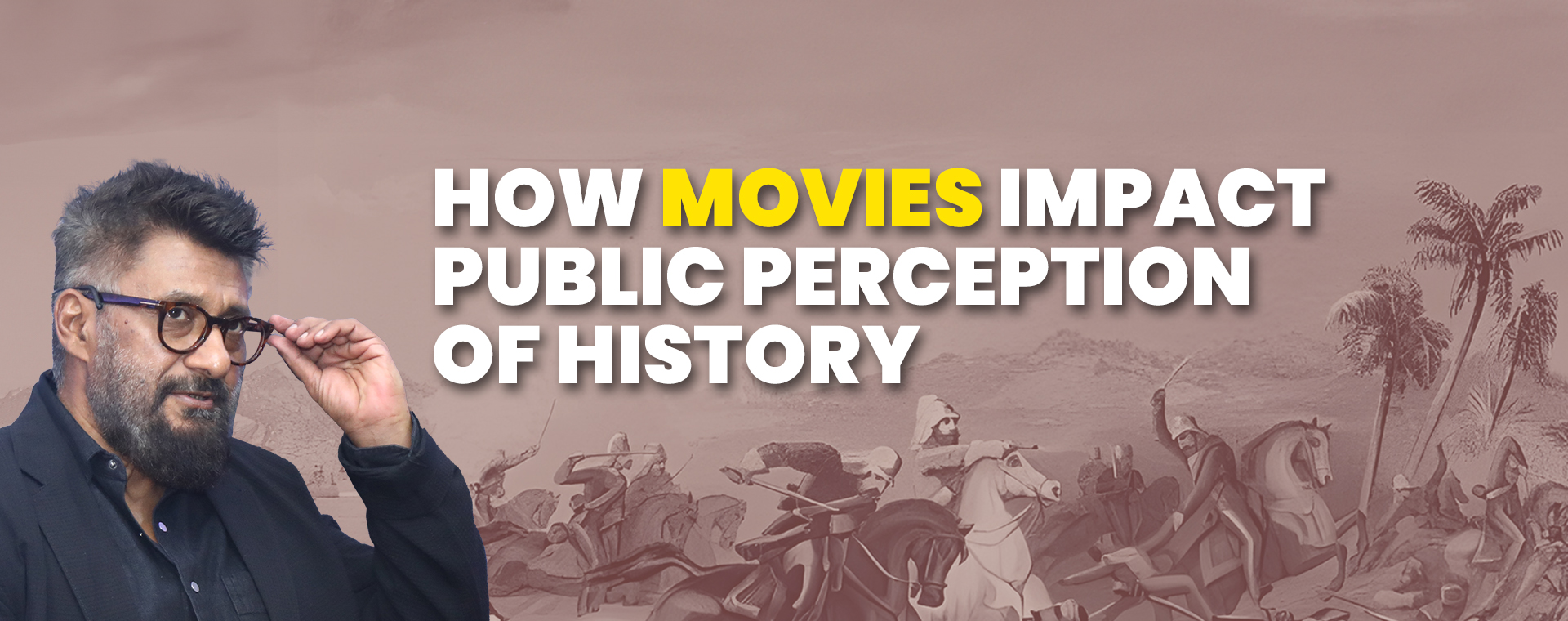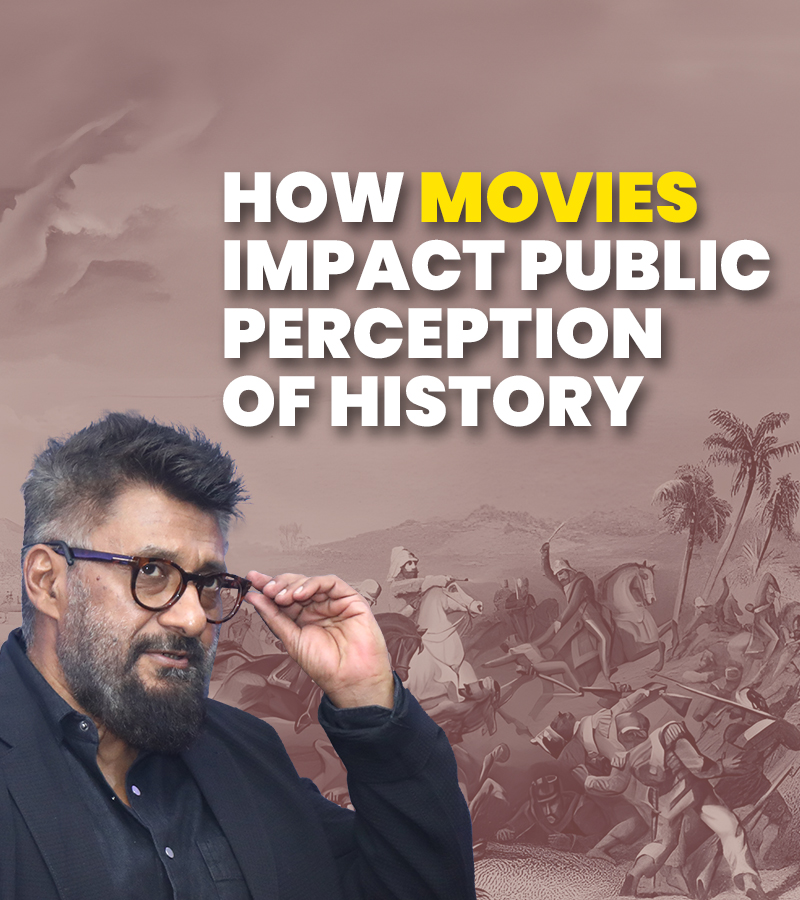

The Role of Cinema in Shaping Public Perception of History: A Deep Dive with Vivek Ranjan Agnihotri
Discover how his films do more than entertain; they spark debates, open forgotten chapters, and invite us to see the past through a lens that is as provocative as it is enlightening.
Cinema has long been a potent medium for storytelling, capable of conveying complex historical narratives in a way that is accessible and engaging for a broad audience. Among the filmmakers who have effectively harnessed the power of cinema to shape public perception of history, Vivek Agnihotri stands out. His unique disruptive filmmaking style, and dedication to telling untold stories have significantly contributed to how history is viewed in contemporary India. This blog explores how Agnihotri’s work has influenced public understanding of historical events and discusses the broader role of cinema in shaping historical consciousness.
1. Vivek Agnihotri: The Filmmaker and His Journey
Vivek Ranjan Agnihotri embarked on his journey in the entertainment industry with a unique approach, tackling controversial and often overlooked subjects. His directorial debut, Chocolate: Deep Dark Secrets (2005), was a thriller that hinted at his narrative bravery, setting the stage for his later historical and socio-political works. Over the years, Agnihotri has carved a niche for himself by focusing on content that not only entertains but also educates and provokes thought.
His Major Works:
Buddha in a Traffic Jam (2016): This film tackled the complex interconnections of urban disaffection, student politics, and the ideological warfare of contemporary India, indicating his shift towards more socially relevant cinema.
The Tashkent Files (2019): Agnihotri ventured into the political thriller genre with a focus on the mysterious death of former Indian Prime Minister Lal Bahadur Shastri. This film challenged the audience to question the narratives fed by mainstream media and history books.
The Kashmir Files (2022): Perhaps his most impactful film delves into the painful exodus of Kashmiri Pandits in the 1990s. This movie stirred a significant conversation in India and abroad. It demonstrated how cinema could be a powerful tool for bringing historical issues to the forefront of public discourse.
2. The Impact of Agnihotri’s Films on Public Perception
Agnihotri’s films often spark debate and dialogue, encouraging viewers to delve deeper into historical events they may need to be fully aware of or understand. Through his work, he invites the audience to see beyond the surface of mainstream history and explore the narratives that have been overshadowed or altered.
Audience Engagement:
The reception of Agnihotri’s films, particularly The Kashmir Files, demonstrated the immense power of cinema to engage audiences in historical discourse. The film’s raw portrayal of the Kashmiri Pandit exodus sparked discussions across various platforms, from academic circles to coffee tables, underscoring cinema’s role as a catalyst for conversation and reflection.
Educational Role:
Agnihotri’s approach to filmmaking serves a significant educational purpose, filling gaps in the general public’s historical knowledge. By bringing lesser-known stories to light, his films provide a platform for marginalized voices and perspectives, contributing to a more inclusive and comprehensive understanding of India’s past.
3. Cinema as a Medium for Historical Narrative
Cinema, with its vast reach and transformative power, has the unique ability to shape public perception of history. Films can introduce audiences to new perspectives, challenge existing biases, and foster empathy and understanding, leaving them enlightened and more aware of the complexities of historical narratives.
Emotional Connection:
Films, with their ability to create emotional connections, make historical events more relatable and humanized. This emotional engagement is crucial in ensuring that history lessons are learned and felt, leading to a deeper appreciation and understanding of the past, and making the audience feel more engaged with the narrative.
Accessibility:
Unlike academic texts, films are more accessible to a general audience. They provide a gateway to understanding complex historical events through a more digestible format, which is vital in educating a broader audience about their heritage and the world’s history.
4. Challenges and Responsibilities
While cinema can be a powerful educational tool, filmmakers like Agnihotri face significant challenges. There is the challenge of balancing artistic expression with historical accuracy, the risk of personal and political backlash, and the responsibility of handling sensitive subjects with the respect they deserve.
Ethical Filmmaking:
The ethical responsibility in historical filmmaking is immense. Filmmakers must navigate the fine line between dramatization and factual representation, ensuring their creative liberties do not distort historical truth. This responsibility underscores the gravity of their role in shaping historical perception and making the audience feel the weight of their decisions.
5. The Global Context: Cinema and Historical Perception Worldwide
The influence of cinema on historical perception isn’t confined to Indian cinema; it’s a global phenomenon. Films from Hollywood, such as Schindler’s List and Saving Private Ryan, have played significant roles in shaping perceptions of World War II. Much like Agnihotri’s work, these films blend dramatic storytelling with factual bases to engage and educate audiences about significant historical events.
The Role of Film Festivals and International Circuits:
Film festivals and international screenings extend the reach of films like those made by Agnihotri, allowing them to influence a global audience. These platforms enhance the visibility of diverse historical narratives and encourage cross-cultural dialogue about historical interpretation and its impact on contemporary issues.
Influence on Educational Curriculums:
In some cases, films have even influenced educational curriculums. For example, movies that accurately depict historical events are increasingly being used as teaching aids in classrooms worldwide. This trend underscores the potential of film to complement traditional educational materials, making history more palpable and impactful for students.
The Power of Narrative:
Vivek Agnihotri’s films exemplify how cinema can play a pivotal role in shaping our understanding of history. As we reflect on his contributions, it becomes clear that cinema does not just tell stories; it creates the lens through which we view our past, understand our present, and imagine our future. By engaging with films like Agnihotri’s, audiences can participate in an ongoing dialogue about history, learning to question, understand, and appreciate the complex tapestry of human experience that shapes our world.






